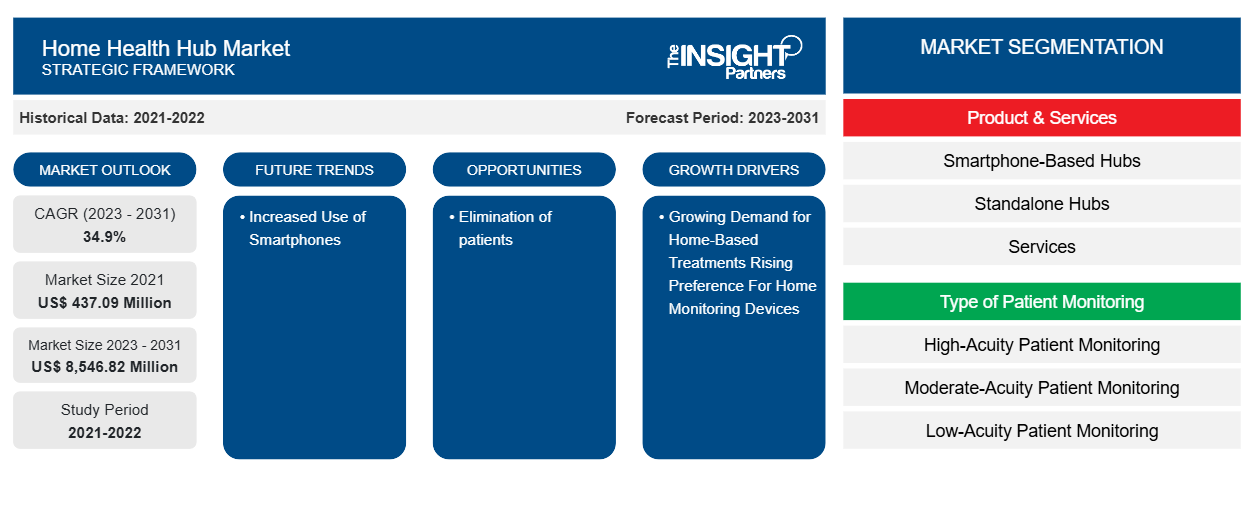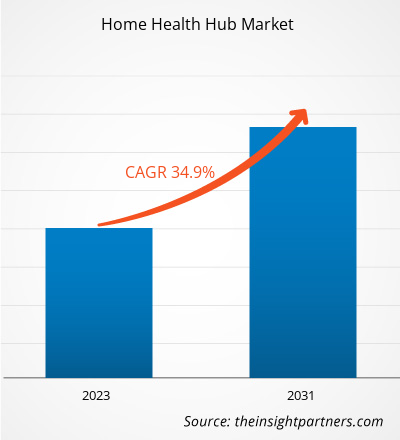Home Health Hub Market Key Companies and SWOT Analysis by 2031
Historic Data: 2021-2022 | Base Year: 2021 | Forecast Period: 2023-2031Home Health Hub Market Size and Forecast (2021 - 2031), Global and Regional Share, Trend, and Growth Opportunity Analysis Report Coverage: By Product & Services (Smartphone-Based Hubs, Standalone Hubs, and Services), Type of Patient Monitoring (High-Acuity Patient Monitoring, Moderate-Acuity Patient Monitoring, and Low-Acuity Patient Monitoring), End User (Hospitals, Healthcare Payers and Home Care Agencies), and Geography
- Report Date : Mar 2026
- Report Code : TIPHE100001408
- Category : Technology, Media and Telecommunications
- Status : Data Released
- Available Report Formats :


- No. of Pages : 150
The home health hub market size in 2021 stood at US$ 437.09 million and is projected to reach US$ 8,546.82 million by 2031 from US$ XX million in 2023. The market is expected to register a CAGR of 34.9% in 2023–2031. Remote monitoring would soon eliminate patients’ routine visits to hospitals is likely to remain key home health hub trends.
Home Health Hub Market Analysis
The increasing public interest in health and wellness tracking is fueling the market growth. Furthermore, the necessity to reduce medical costs and the growing trend of smart homes drive market growth. The rapid expansion of digital health innovations and technical progress by various market players focuses on continual updates to improve patient care quality. Also, the demand for home health hubs is raising as the population ages and chronic diseases become more common.
Home Health Hub Market Overview
The home health hub market has emerged as a game changer in the healthcare business, providing an broad range of services and solutions that allow patients to obtain quality care in the comfort in their own homes. These new technologies and platforms serve as a centralized hub, easily connecting patients, caregivers, and healthcare professionals.
Customize This Report To Suit Your Requirement
You will get customization on any report - free of charge - including parts of this report, or country-level analysis, Excel Data pack, as well as avail great offers and discounts for start-ups & universities
Home Health Hub Market: Strategic Insights

-
Get Top Key Market Trends of this report.This FREE sample will include data analysis, ranging from market trends to estimates and forecasts.
Home Health Hub Market Drivers and Opportunities
Growing Demand for Home-Based Treatments to Favor Market Growth
During the pandemic, demand for at-home care increased as patients were discharged from hospitals and moved to their homes. Lockdowns, social isolation, and fewer people ready to see their doctor in person all likely contributed to this trend, which led to reach new groups of patients across the health spectrum and age groups to at-home care.
Increased Use of Smartphones
The rising use of mobile platforms to improve patient information accessibility is driven by increased smartphone usage and the ongoing expansion of high-speed mobile networks. Smartphone-enabled home health hubs will gain popularity as awareness and accessibility improve. An increasing desire for smartphone technology and the internet and increased demand for smartphone-based health hubs will offer lucrative opportunities for the home health hub market.
Home Health Hub Market Report Segmentation Analysis
Key segments that contributed to the derivation of the home health hub analysis are product & services, type of patient monitoring, and end user.
- Based on product & services, the home health hub is divided into smartphone-based hubs, standalone hubs, and services. Rremote patient monitoring services, and support & maintenance services are two prominent subsegments under the services segment. The standalone hubs segment held a larger market share in 2023.
- By type of patient monitoring, the market is segmented into high-acuity patient monitoring, moderate-acuity patient monitoring, and low-acuity patient monitoring. The high-acuity patient monitoring segment held the largest share of the market in 2023.
- In terms of end user, the market is segmented into hospitals, healthcare payers, and home care agencies. The hospitals segment dominated the market in 2023.
Home Health Hub Market Share Analysis by Geography
The geographic scope of the home health hub report is mainly divided into five regions: North America, Asia Pacific, Europe, Middle East & Africa, and South & Central America.
North America has dominated the home health hub. The North America home health hub market growth is expected to grow due to the growing prevalence of chronic diseases, increasing geriatric population, and the rising awareness among consumers about aggregating information.
Home Health Hub Market Regional InsightsThe regional trends and factors influencing the Home Health Hub Market throughout the forecast period have been thoroughly explained by the analysts at The Insight Partners. This section also discusses Home Health Hub Market segments and geography across North America, Europe, Asia Pacific, Middle East and Africa, and South and Central America.
Home Health Hub Market Report Scope
| Report Attribute | Details |
|---|---|
| Market size in 2021 | US$ 437.09 Million |
| Market Size by 2031 | US$ 8,546.82 Million |
| Global CAGR (2023 - 2031) | 34.9% |
| Historical Data | 2021-2022 |
| Forecast period | 2023-2031 |
| Segments Covered |
By Product & Services
|
| Regions and Countries Covered |
North America
|
| Market leaders and key company profiles |
|
Home Health Hub Market Players Density: Understanding Its Impact on Business Dynamics
The Home Health Hub Market is growing rapidly, driven by increasing end-user demand due to factors such as evolving consumer preferences, technological advancements, and greater awareness of the product's benefits. As demand rises, businesses are expanding their offerings, innovating to meet consumer needs, and capitalizing on emerging trends, which further fuels market growth.

- Get the Home Health Hub Market top key players overview
Home Health Hub Market News and Recent Developments
The home health hub is evaluated by gathering qualitative and quantitative data post primary and secondary research, which includes important corporate publications, association data, and databases. The following is a list of developments in the market for home health hub:
- VEON Ltd., a leading global provider of connectivity and internet services, announces that its Banglalink mobile operator in Bangladesh has launched Health Hub, the country’s first integrated digital health platform. (Source: VEON LTD, Press Release, 2022)
- Philips, a global leader in health technology, nnounced that it has signed an agreement to acquire Capsule Technologies, Inc., a leading provider of medical device integration and data technologies for hospitals and healthcare organizations. The acquisition of Capsule is a strong fit with Philips’ strategy to transform the delivery of care along the health continuum with integrated solutions. (Source: Koninklijke Philips N.V, Press Release, 2021)
Home Health Hub Market Report Coverage and Deliverables
The “Home Health Hub Market Size and Forecast (2021–2031)” report provides a detailed analysis of the market covering below areas:
- Market size and forecast at global, regional, and country levels for all the key market segments covered under the scope
- Market dynamics such as drivers, restraints, and key opportunities
- Key future trends
- Detailed PEST/Porter’s Five Forces and SWOT analysis
- Global and regional market analysis covering key market trends, major players, regulations, and recent market developments
- Industry landscape and competition analysis covering market concentration, heat map analysis, prominent players, and recent developments
- Detailed company profiles
Ankita is a dynamic market research and consulting professional with over 8 years of experience across the technology, media, ICT, and electronics & semiconductor sectors. She has successfully led and delivered 100+ consulting and research assignments for global clients such as Microsoft, Oracle, NEC Corporation, SAP, KPMG, and Expeditors International. Her core competencies include market assessment, data analysis, forecasting, strategy formulation, competitive intelligence, and report writing.
Ankita is adept at handling complete project cycles—from pre-sales proposal design and client discussions to post-sales delivery of actionable insights. She is skilled in managing cross-functional teams, structuring complex research modules, and aligning solutions with client-specific business goals. Her excellent communication, leadership, and presentation abilities have enabled her to consistently deliver value-driven outcomes in fast-paced and evolving market environments.
- Historical Analysis (2 Years), Base Year, Forecast (7 Years) with CAGR
- PEST and SWOT Analysis
- Market Size Value / Volume - Global, Regional, Country
- Industry and Competitive Landscape
- Excel Dataset
Recent Reports
Testimonials
The Insight Partners' SCADA System Market report is comprehensive, with valuable insights on current trends and future forecasts. The team was highly professional, responsive, and supportive throughout. We are very satisfied and highly recommend their services.
RAN KEDEM Partner, Reali Technologies LTDsI requested a report on a very specific software market and the team produced the report in a few days. The information was very relevant and well presented. I then requested some changes and additions to the report. The team was again very responsive and I got the final report in less than a week.
JEAN-HERVE JENN Chairman, Future AnalyticaWe worked with The Insight Partners for an important market study and forecast. They gave us clear insights into opportunities and risks, which helped shape our plans. Their research was easy to use and based on solid data. It helped us make smart, confident decisions. We highly recommend them.
PIYUSH NAGPAL Sr. Vice President, High Beam GlobalThe Insight Partners delivered insightful, well-structured market research with strong domain expertise. Their team was professional and responsive throughout. The user-friendly website made accessing industry reports seamless. We highly recommend them for reliable, high-quality research services
YUKIHIKO ADACHI CEO, Deep Blue, LLC.This is the first time I have purchased a market report from The Insight Partners.While I was unsure at first, I visited their web site and felt more comfortable to take the risk and purchase a market report.I am completely satisfied with the quality of the report and customer service. I had several questions and comments with the initial report, but after a couple of dialogs over email with their analyst I believe I have a report that I can use as input to our strategic planning process.Thank you so much for taking the extra time and making this a positive experience.I will definitely recommend your service to others and you will be my first call when we need further market data.
JOHN SUZUKI President and Chief Executive Officer, Board Director, BK TechnologiesI wish to appreciate your support and the professionalism you displayed in the course of attending to my request for information regarding to infectious disease IVD market in Nigeria. I appreciate your patience, your guidance, and the fact that you were willing to offer a discount, which eventually made it possible for us to close a deal. I look forward to engaging The Insight Partners in the future, all thanks to the impression you have created in me as a result of this first encounter.
DR CHIJIOKE ONYIA MANAGING DIRECTOR, PineCrest Healthcare Ltd.Reason to Buy
- Informed Decision-Making
- Understanding Market Dynamics
- Competitive Analysis
- Identifying Emerging Markets
- Customer Insights
- Market Forecasts
- Risk Mitigation
- Boosting Operational Efficiency
- Strategic Planning
- Investment Justification
- Tracking Industry Innovations
- Aligning with Regulatory Trends




















 Get Free Sample For
Get Free Sample For